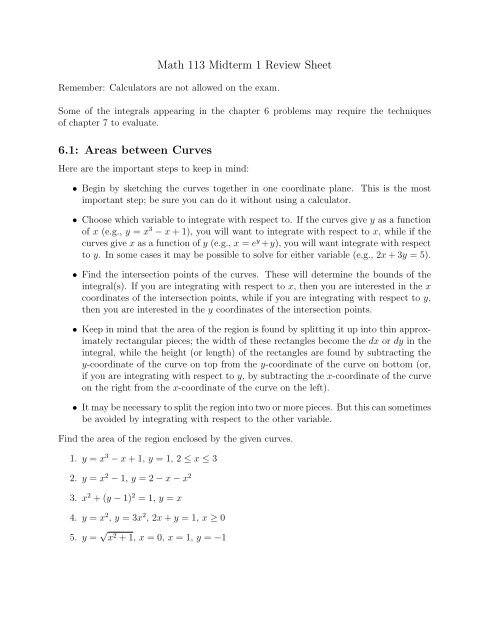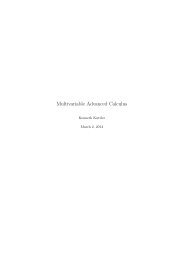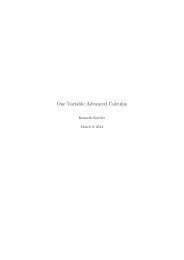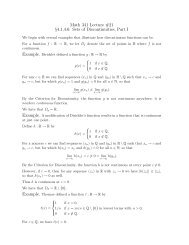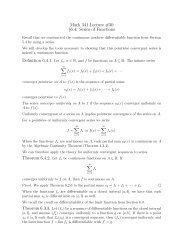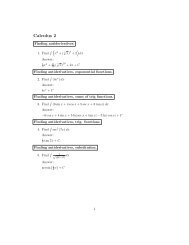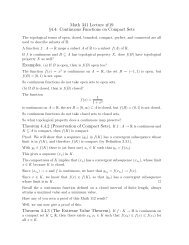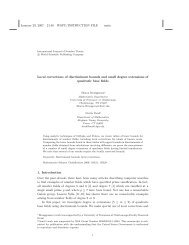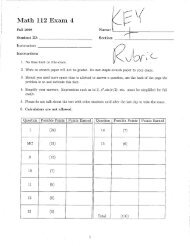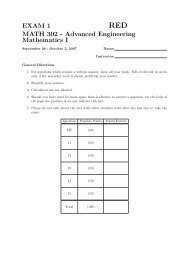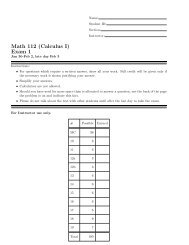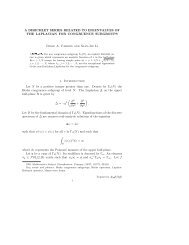Math 113 Midterm 1 Review Sheet 6.1: Areas between Curves
Math 113 Midterm 1 Review Sheet 6.1: Areas between Curves
Math 113 Midterm 1 Review Sheet 6.1: Areas between Curves
Create successful ePaper yourself
Turn your PDF publications into a flip-book with our unique Google optimized e-Paper software.
<strong>Math</strong> <strong>113</strong> <strong>Midterm</strong> 1 <strong>Review</strong> <strong>Sheet</strong>Remember: Calculators are not allowed on the exam.Some of the integrals appearing in the chapter 6 problems may require the techniquesof chapter 7 to evaluate.<strong>6.1</strong>: <strong>Areas</strong> <strong>between</strong> <strong>Curves</strong>Here are the important steps to keep in mind:• Begin by sketching the curves together in one coordinate plane. This is the mostimportant step; be sure you can do it without using a calculator.• Choose which variable to integrate with respect to. If the curves give y as a functionof x (e.g., y = x 3 − x + 1), you will want to integrate with respect to x, while if thecurves give x as a function of y (e.g., x = e y +y), you will want integrate with respectto y. In some cases it may be possible to solve for either variable (e.g., 2x + 3y = 5).• Find the intersection points of the curves. These will determine the bounds of theintegral(s). If you are integrating with respect to x, then you are interested in the xcoordinates of the intersection points, while if you are integrating with respect to y,then you are interested in the y coordinates of the intersection points.• Keep in mind that the area of the region is found by splitting it up into thin approximatelyrectangular pieces; the width of these rectangles become the dx or dy in theintegral, while the height (or length) of the rectangles are found by subtracting they-coordinate of the curve on top from the y-coordinate of the curve on bottom (or,if you are integrating with respect to y, by subtracting the x-coordinate of the curveon the right from the x-coordinate of the curve on the left).• It may be necessary to split the region into two or more pieces. But this can sometimesbe avoided by integrating with respect to the other variable.Find the area of the region enclosed by the given curves.1. y = x 3 − x + 1, y = 1, 2 ≤ x ≤ 32. y = x 2 − 1, y = 2 − x − x 23. x 2 + (y − 1) 2 = 1, y = x4. y = x 2 , y = 3x 2 , 2x + y = 1, x ≥ 05. y = √ x 2 + 1, x = 0, x = 1, y = −1
6.2 & 6.3: VolumesThe guidelines above also apply to these problems. For solids of revolution, you will haveto decide whether to use the method of slicing or cylindrical shells:• If the axis along which you are integrating is parallel to the axis of rotation, use themethod of slicing. If the axis along which you are integrating is perpendicular to theaxis of rotation, use the method of cylindrical shells.• Keep in mind that the volume of the solid is found by splitting up the region intothin approximately rectangular pieces and considering the volume swept out by eachof these rectangles when they are revolved about the appropriate axis. Each smallrectangle (which in the limit becomes simply a line segment) will sweep out either awasher or a cylindrical shell. Visualizing this process will make it easy to determinewhich method is applicable for a given problem.• The area of a washer is π(r 2 out − r 2 in), where r out is the radius of the outer circle andr in is the radius of the inner circle; r out and r in are found by measuring the distancefrom the two curves to the axis of rotation.• The area of a cylindrical shell is 2πrh, where r is the radius (distance to the axisof rotation) and h is the height of the cylinder (found by subtracting: the top curveminus the bottom curve, or the right curve minus the left curve, depending on whichvariable we are integrating with respect to).• Some solids do not result from revolving a region about an axis. For such solids, themethod of cylindrical shells is not possible. The volume must be found by slicing.To do this, choose an axis along which to integrate; identify the type of cross sectionsperpendicular to this axis (whether they be triangles, squares, disks, etc.); andcalculate the area of such cross sections. The volume is the integral of these areas.Find the volume of the solid obtained by revolving the region bounded by the given curvesabout the given axis.6. y = 4 − x 2 , y = 0; about the x-axis7. x = −y − 1, x = e y , 0 ≤ y ≤ 1; about the x-axis8. y = sin x + 1, y = −1, x = 0, x = π ; about the line x = −149. y = sec x, y = 0, x = 0, x = π ; about the line y = 3310. x = √ y + y, x = 0, y = 0, y = 1; about the line y = −1Find the volume of the solid described.11. The base of the solid is the unit disk x 2 + y 2 ≤ 1. Cross sections perpendicular tothe x-axis are squares.12. The base of the solid is the region enclosed by the curves x + y = 1, x + y = −1,x − y = 1, and x − y = −1. Cross sections perpendicular to the x-axis are equilateraltriangles.
6.4: WorkThe work done by a force on an object is given by W = F d, where F is the magnitudeof the force and d is the displacement of the object in the direction of the force. In eachproblem, it is important to first establish a coordinate system: decide where to placethe origin and in which direction to point the positive axis.• If a varying force acts on an object, you should divide the axis of the object’s movementinto small intervals and calculate the work done by the force on the object asit moves over the length of each small interval.• If the object consists of parts, each of which is to be displaced by a different amount,divide the object into small parts and calculate the work done by the force in movingeach part of the object to its final location.13. A chain weighing 3 lb/ft is used to lift a 500 lb object a height of 20 ft, to the levelof the top of the chain. Find the work done.14. A particle is moved along the x-axis from the origin a distance of 5 meters by a forcewhich varies depending on the position of the particle. When the particle is at x, theforce is (2x + 1)/(x + 1) newtons in the positive direction. Find the work done by theforce on the particle. [Hint: Use long division to simplify the integrand.]15. A force of 20N is required to hold a spring stretched 40cm, while a force of 30N isrequired to hold it stretched 45cm. How much work is required to stretch the springfrom 50cm to 60cm? [Hint: Find the natural length of the spring.]16. The great pyramid of Giza consists of approximately 2 million stones, each weighing1.5 tons (3000 lb). The pyramid is 450 ft high with a square base measuring 750ft. Find the work required to lift the stones into place from ground level. [Hint:To simplify your calculations, work the problem symbolically; only plug in the givennumbers at the last step.]7.1: Integration by Parts∫∫u dv = uv −v du• Integration by parts is most often useful when integrating a function of the formx n e x , x n sin x, x n cos x, x n ln x. If possible, you want to choose u to be a functionthat becomes simpler when differentiated, and dv to be a function that can be readilyintegrated. This usually means you should choose u = x n . (But in the case x n ln x,choose u = ln x).• Integration by parts is also useful for integrating inverse functions such as sin −1 x,tan −1 x, ln x or functions involving these as factors. In this case, you should chooseu = sin −1 x, u = tan −1 x, or u = ln x accordingly, even if there are no other factorsin the integrand (i.e., you can set dv = dx).Evaluate the following integrals.17. ∫ x cos x dx
18. ∫ π 20 x sin x dx19. ∫ 10 x2 e x dx20. ∫ 10 sin−1 x dx21. ∫ 2x tan −1 x dx22. ∫ ln xx 2dx23. ∫ e x cos x24. ∫ π√ πx 3 sin(x 2 ) dx [Hint: First use a u-substitution]27.2: Trigonometric Integrals-sin and cos only• For ∫ sin m x cos n x dx:If n is odd, save one cos x and convert the rest to sin using cos 2 x = 1 − sin 2 xIf m is odd, save one sin x and convert the rest to cos using sin 2 x = 1 − cos 2 xIf both m and n are even, use the identities sin 2 1−cos 2xx = and cos 2 x =2If the periods of sin and cos are different, use the product formulas.Evaluate the following integrals:25. ∫ π 60 sin 2 x cos 3 x dx26. ∫ π 30 cos 4 x dx27. ∫ π 40 sin 5 (2x) cos 4 (2x) dx28. ∫ sin(2x) cos(5x) dx1+cos 2x2.
Answers1.5542.125243.π4 − 1 24.43√2 −50275. 1 + 1 2√2 +12 ln(√ 2 + 1)6.51215 π7.<strong>113</strong> π8. π( π28 − √ 24 π + π + 2)9. π(6 ln(2 + √ 3) − √ 3)10.195 π11. 412.23√313. 10600 ft-ln14. 10 − ln 615. 5 J16. 675,000,000 ft-lb17. x sin x + cos x + C18. 119. e − 220.π2 − 121. x 2 tan −1 x − x + tan −1 x + C22.13 x3 ln x − 1 9 x3 + C23.12 ex (sin x + cos x) + C124. (π − 1)225.1748026.π8 + 764√327.431528. −1/14 cos (7 x) + 1/6 cos (3 x) + C


